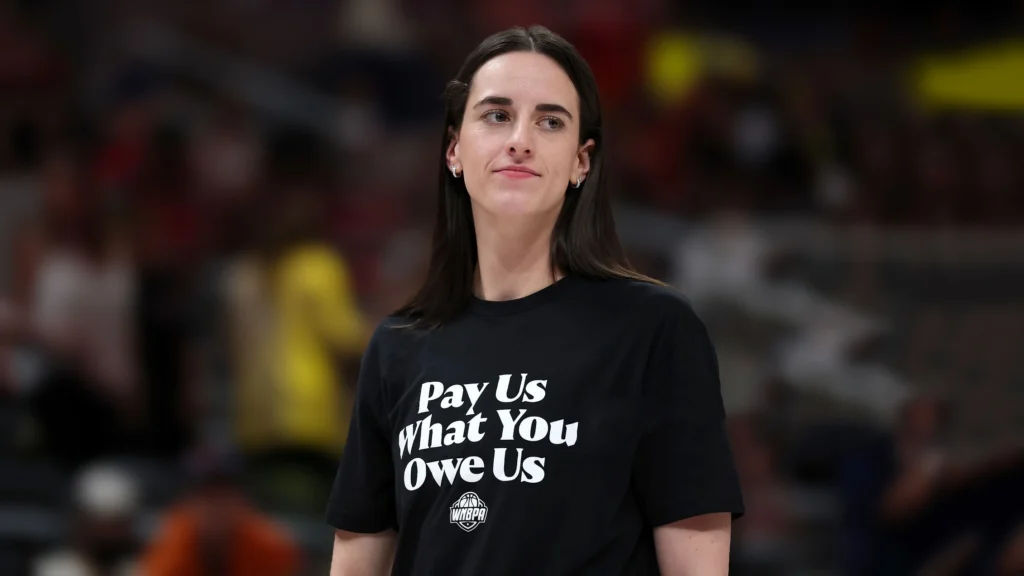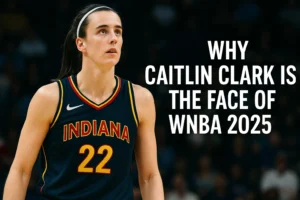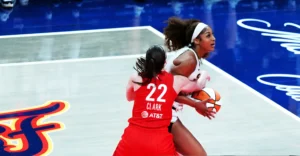
INDIANAPOLIS, IN – The WNBA, a league experiencing an unprecedented surge in popularity and financial growth, finds itself at a critical juncture. As the 2025 WNBA All-Star Game lit up Indianapolis this past weekend, a powerful, unified message overshadowed the dazzling dunks and pinpoint passes: “Pay Us What You Owe Us.” This isn’t merely a slogan; it’s a battle cry from the Women’s National Basketball Players Association (WNBPA) and its members, demanding a fair share of the booming revenue as contentious Collective Bargaining Agreement (CBA) negotiations loom.
The sight of superstars like Caitlin Clark, Napheesa Collier, and Angel Reese warming up in black T-shirts emblazoned with the stark message sent an unmistakable signal to the league and its owners: the players are united, and they are not backing down. This public display of solidarity underscores the urgency of the situation, with the current CBA set to expire at the end of the 2025 season. The WNBPA opted out of the agreement in October 2024, signaling their intent to secure a truly transformative deal for the future of women’s professional basketball.
At the heart of the dispute lies the stark disparity in revenue sharing. While NBA players enjoy approximately 50% of basketball-related income, WNBA players currently receive a mere fraction, often reported to be around 20-25% of league revenue, and some sources even put it as low as 9.3% of total league revenue. This imbalance feels particularly egregious given the WNBA’s explosive growth. Television ratings are soaring, attendance records are being shattered, and team valuations are skyrocketing. New media rights deals are projected to inject billions into the league, and expansion fees for new franchises are reaching staggering figures. The players, who are the very engine of this success, believe their compensation should reflect this prosperity.
“We’re not asking for what the men get paid, we’re asking for the same percentage of revenue shared,” stated Los Angeles Sparks veteran Kelsey Plum in a past interview, a sentiment echoed by many across the league. This isn’t about matching NBA salaries dollar-for-dollar; it’s about a fundamental principle of equitable distribution. Players are advocating for a system where their earnings are directly tied to the league’s overall financial health, ensuring they benefit proportionally from the immense value they generate.
Beyond salaries, the WNBPA’s demands extend to crucial improvements in working conditions. Issues such as enhanced travel standards (including more charter flights), better access to facilities, and comprehensive maternity and family planning benefits are vital to player welfare and career longevity. Many WNBA athletes are forced to play overseas during the offseason to supplement their incomes, a grueling schedule that impacts their bodies and personal lives. A more robust CBA would alleviate this necessity, allowing players to prioritize their health and family while still earning a living wage in the WNBA.
The negotiations, particularly an in-person meeting during the All-Star weekend, have been described as “disappointing” and a “wasted opportunity” by union leaders and players alike. Satou Sabally of the Phoenix Mercury famously called the league’s initial proposal “a slap in the face,” highlighting the significant gap between the players’ expectations and the league’s offers. Breanna Stewart, a WNBPA vice president, emphasized that the league’s proposals “fail to address the priorities we’ve voiced.”
With the October 31st deadline fast approaching, the specter of a work stoppage looms large. Players are reportedly “bracing” for this possibility, and the WNBPA has made it clear they are “committed to the fight” and “will not stop until we achieve the transformational CBA this moment demands.” The unity demonstrated by the players, from seasoned veterans to electrifying rookies, suggests a strong resolve to see their demands met.
The WNBA is at a pivotal moment. Its future success hinges not only on its captivating on-court product but also on its ability to foster a truly equitable partnership with the athletes who make it all possible. The “Pay Us What You Owe Us” movement is a testament to the collective power of these athletes, and the world is watching to see if the league will deliver on its promise of a bright and prosperous future for all.

